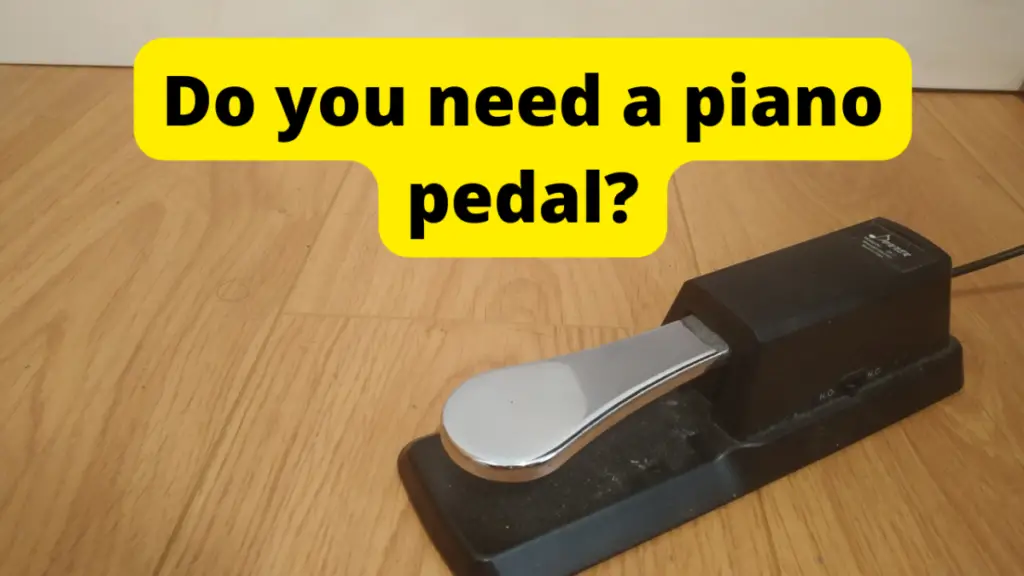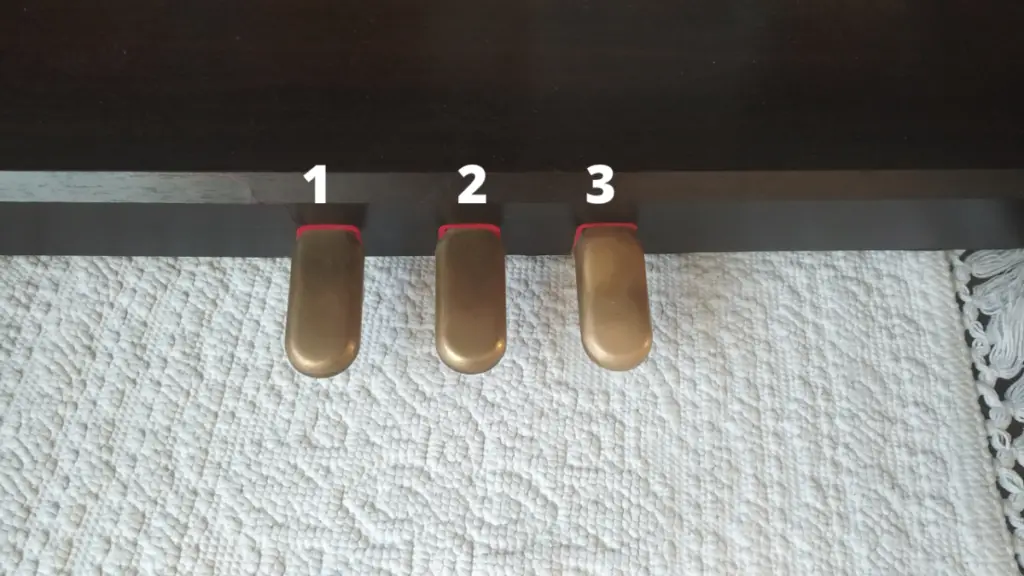This post contains affiliate links.

As you are getting a new piano keyboard, you may wonder about the three pedals commonly seen under acoustic pianos. What are those pedals for and do you need all 3 of them for your keyboard?
For a piano keyboard, you at least need the sustain pedal since it’s the most commonly used pedal out of the three pedals. A sustain pedal prolongs the sounds of notes when engaged, adding nuances and expressiveness to the melodies.
This article will explain the roles of each of the pedals seen on a piano, convincing you why getting a pedal is necessary, the different types of pedals you can get, along with showing you how to use the sustain pedal properly to level up your playing.
Roles of pedals on a piano
There are 3 pedals seen on an acoustic piano:
- The left-most is called a soft pedal (number 1)
- The center is called sostenuto or practice pedal (number 2)
- While the furthest right is called a sustain pedal (number 3)

Soft pedal: the role of the soft pedal is to make the sound played softer and slightly quieter when being stepped on.
How it works: when the soft pedal is stepped on, either the hammers will all shift to the side so that they will each only hit one string instead of three (each key on the keyboard is connected to 3 strings)
Or by moving the hammers closer to the strings, so they will have less space to accelerate when a key is pressed, meaning the hammers will hit the strings at a lower speed.
The result is a softer and slightly quieter sound from fewer vibrations of the strings
Sostenuto or practice pedal: this pedal has a different function on a grand piano compared to an upright piano.
On a grand piano, the sostenuto allows for certain notes to be sustained while the rest are played normally.
How it works: when you hit a note or a chord on the keyboard and then step on the middle pedal, the dampers are lifted up for those notes only, allowing those strings to continue vibrating and the notes sustained while the other keys work normally if you then hit them.
On an upright piano, the sostenuto/practice pedal has a completely different function. It acts as a volume knob, making the sound quieter, making it suitable for playing in apartments, where you may not want to disturb your neighbours next door.
How it works: when the practice pedal is stepped on, a felt cloth is lowered between the dampers and the strings, making the sound quieter. However, the touch of keys under this pedal is different than normal, so avoid piano practice with this pedal for long periods.
Sustain pedal: as the name suggests, the role of the sustain pedal is to sustain the notes play, making them last longer even if you then move your hands off the keys
How it works: normally, a damper lifts up when you press a key and come down when you release the key, immediately stopping the strings from vibrating and creating sounds.
When you step on a sustain pedal, all the dampers are lifted up, thus allowing the strings to continue vibrating and creating sustained sounds for any keys you hit afterwards.
Here’s a video demonstrating what each of the pedals does:
The pedal you need as a beginner
For beginners to intermediate-level players, a sustain pedal is the only pedal that you need since a lot of piano pieces require sustained notes in them.
Once you get to a more advanced level then you can start incorporating the soft and sostenuto pedal to add more complexities and nuances to your playing.
Furthermore, for a lot of piano keyboards, there’s only one jack to connect a pedal and it’s reserved for a sustain pedal only.
The reason why you need a pedal for your keyboard
The reason why a lot of piano pieces require notes to be sustained is that it adds nuances to the melodies. A pedal creates a huge difference in sound quality compared to not using one.
For example, here are 2 examples of a passage of Adele’s Skyfall, one without pedal used and one with pedal:
As you can hear, the notes don’t feel very connected and are kind of bland without using the pedal. But once the pedal is in play, everything changes. There’s a massive difference in the sound, it’s way more expressive and there’s more cohesion to the melodies.
That’s why it’s important to also get a pedal when you buy a piano keyboard
Beginner-friendly piano piece to learn pedals
By the way, if you looking for a beginner-level piece that can teach you how to use the pedal, I recommend you learn how to play Chopin’s Prelude in C Minor, Op.28, No.20. It’s a great and powerful sounding piece.
There are only 3 bars for the whole piece with all chords with the 3rd bar being the exact same as the 2nd bar, only played softer and quieter. The rhythm is not that complicated and also constant throughout the piece, using only quarter and eighth notes.
The tricky part about this piece is that there are a lot of notes. You can choose to write down the notes to make it easier. However, I find forcing myself to be able to identify the notes, the notes stick in my head better.
This piece will teach you how to read notes inside and outside of the clefs. You will also learn how to place hands to reach for awkward and complicated chords, and it’s an easy piece to start learning how to use the piano pedal.
For this piece, you need to re-engage the pedal each time your hand moves to a new chord.
Here’s the link to download the piece.
Here’s a tutorial on how to play it:
How to use the pedal when playing piano
I’m going to be honest: the world will be such an easier place to live if we can just press our foot on the pedal and hold it for the whole duration of the piece. Sadly, the world is a cruel, cold place, and that’s not how to use a piano pedal.
Here is an example for the same Skyfall passage, only this time the pedal is held throughout the playing:
Uhh that doesn’t sound too good, does it? That’s because the different sustained chords clash against each other, creating an unpleasant sound.
Instead, what you want to do is to sustain the first note/chord then re-engage the pedal once you’re on the next note/chord to avoid them getting jumbled up together.
Here’s how you use the piano pedal:
- Hit the first chord and hold it for 1-2 seconds.
- Then, press your foot on the pedal to sustain the chord
- While keeping your foot on the pedal, move your hands to the next chord and hit it
- While holding onto that chord for 1-2 seconds, lift your foot and step on the pedal again.
- Repeat this process for the next chords
In real-time, you want to step on the pedal almost immediately after you hit the chords.
Obviously, you don’t play chords only in piano pieces, but melodies consisting of single notes also. A good rule of thumb on how to use the pedal, in that case, is to re-engage the pedal each time you are on a different chord.
On the piano sheet itself, this symbol signifies where to use a pedal and for how long. In this case, it’s once for each chord:

Here’s a video guide on how to use the pedal:
Quick tip: while practicing for a piano piece, focus on getting the playing of the notes at the right tempo down first before adding the pedals since it’s hard to juggle between memorizing the notes and hand positions and knowing when to use the pedal at the same time.
Types of digital piano pedals available
Generally, there are two types available on Amazon:
| Black pad pedal | Traditional pedal | |
| Similarities | – Send a signal to the computer inside the keyboard to sustain the note – Sustain the notes as long as you keep your foot on the pedal | – Send a signal to the computer inside the keyboard to sustain the note – Sustain the notes as long as you keep your foot on the pedal |
| Differences | – No mechanical creaking noise – Have a clicky feel when stepped on | – Can have a creaking noise when stepped on – Mimics the look and feel of an acoustic piano’s pedal |
Personally, I got a Donner traditional pedal since I don’t mind the creaking noise and I wanted something that makes transitioning to an actual acoustic piano easier. I’ve used it for 2 years and the pedal is still working great!
Do piano pedals come with keyboards?
Sometimes, a pedal can come with a keyboard as a bundle. However, because piano pedals are cheap so they shouldn’t be a considering factor when buying a new keyboard.
Sustaining a piano keyboard without a pedal
Some models have buttons or options to sustain notes without using a pedal like the YAMAHA E463:
However, as you can hear, the sounds are all muddled up together, and so in my opinion, it’s still better to get a dedicated sustain pedal. You’ll learn how to use it properly and be more ready when it’s time to transition to an acoustic piano.
Sustain pedals for MIDI controllers and synthesizers
If you are into music production, some MIDI controllers and synthesizers have a jack for a sustain pedal. Check on the manufacturer’s website for the specs to see if the MIDI controller or the synthesizer has this option.
Some MIDI controllers have buttons that allow sustaining notes. However, having an actual pedal feels more natural to have in combination with hands hitting notes.
Sustain pedals can also be customized to do tasks other than sustaining like switching between different sounds.



